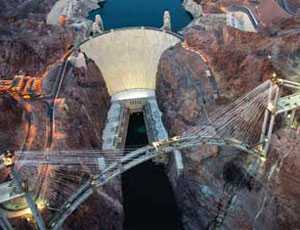Project Manager Dave Zanetell of the U.S. Dept. of Transportation says the Hoover Dam Bypass project illustrates an old-fashioned quality. “It conveys that if managed well, major, unique and technically challenging projects can be delivered by the most skilled team available on budget and on time.”

When completed, the $240-million bypass will enable through-traffic and trucks to avoid the Hoover Dam/Colorado River crossing of U.S. Highway 93 in favor of a new four-lane highway. Exceedingly busy, Highway 93 is not only the major commercial corridor between Arizona, Nevada and Utah but part of the North American Free Trade Agreement route between Mexico and Canada.
It was feared that continued heavy use of inadequate and sharply curved Highway 93 could lead to a disaster involving fatalities, millions of dollars in property damage to the dam, contamination of the river or Lake Mead and interruption of power and water across the Southwest.
The bypass will also deliver other benefits such as reduced travel time and increased protection of the dam and surrounding resources.
Designed to route a significant number of vehicles downstream of the dam, the project requires nearly 3.5 miles of new roadway and a 2,000-ft-long bridge with a minimum clear span of 1,090 ft. The complexity of such an undertaking requires that it be delivered in six distinct, overlapping contracts. Complexity is also reflected in the project’s multifaceted, multilevel project team.
The multiple-agent project management team includes the Federal Highway Administration - Central Federal Lands Division; Arizona Dept. of Transportation; Nevada Dept. of Transportation; Bureau of Reclamation; National Park Service; and Hoover Dam.
The design team, led by HDR, includes additional major firms T.Y. Lin (bridge design lead) and Sverdrup Civil Inc. (roadway and approach structures design).
Scheduled to be fully operational and open to traffic by the fall, the bridge will add a dramatic new concrete arch to the setting of the historic Hoover Dam. At 323 meters long, the concrete arch will be the fourth longest in the world and the longest in the United States.
In addition to the design of the signature long-span bridge, design tasks included roadways, bridges, tunnels, wildlife underpasses and overpasses, corridor architecture and utilities. There also was relocation of high-capacity transmission towers and geotechnical engineering, surveying and mapping. “This truly has been a team effort,” Zanetell says. “It is unique in the way that the agencies and the consulting community have come together to serve a common goal.”

Post a comment to this article
Report Abusive Comment